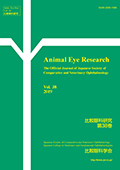
- |<
- <
- 1
- >
- >|
-
Takashi HASEGAWA, Takeshi YAMAMOTO, Yuji SAKAMOTO2019Volume 38 Pages 3-8
Published: December 25, 2019
Released on J-STAGE: December 30, 2021
JOURNAL FREE ACCESSThe corneal protective effects of dodecahydrosqualene (DHS, squalane) were evaluated using an in vitro porcine short-term dry eye model. Fresh porcine eyes with an intact cornea were desiccated for 180 minutes, and administered a tear substitute made of castor oil (CO) solution for human use at a concentration of 0.5%, 1%, or 5%, or 0.5%, 1%, or 5% DHS solution in 60-, 90-, or 180-minute intervals. The staining score of methylene blue (MB), absorbance of MB extracted from the cornea, and the staining density of lissamine green (LG) increased with increasing administration intervals in eyes treated with all tear substitutes containing CO or DHS. A similar degree of corneal protection was observed with both tear substitutes at the same concentration and administration interval. However, DHS solutions exhibited greater corneal protection at a concentration of 0.5% in 180-minute intervals, 1% in 180-minute intervals, and 5% in 60-minute intervals than CO solutions under the same conditions. In addition, there were no significant differences in all MB or LG staining parameters between the control eyes and those administered 5% DHS solution in 60-minute intervals. Histopathological examination revealed the condition of the corneal epithelium treated with 5% DHS solution in 60-minute intervals resembled that in control eyes more than that in eyes administered 5% CO solution under the same treatment conditions. These results suggest that DHS can be used as an alternative lipid product for tear substitutes to treat tear film abnormalities such as keratoconjunctivitis sicca.
View full abstractDownload PDF (1049K)
-
Ayumi NAKAGAWA, Akiko INOUE, Kazuyo SADAMOTO, Seiko KOUZAI, Shingo NEM ...2019Volume 38 Pages 9-13
Published: December 25, 2019
Released on J-STAGE: December 30, 2021
JOURNAL FREE ACCESSLatanoprost is the most commonly used glaucoma drug in humans, and lowers intraocular pressure (IOP) by increasing the outflow of aqueous humor through the uveoscleral pathway. In this study, the usefulness of 0.005% latanoprost ophthalmic solution (VETLATAN®, Senju Pharmaceutical Co., Ltd., Osaka) was investigated by performing a pharmacological, pharmacokinetic, and toxicological study in dogs. IOP significantly decreased after a single topical administration of 0.005% latanoprost ophthalmic solution, although it tended to return to baseline 20 hours after administration. In contrast, twice administration of the drug, 12 hours apart, caused significant IOP reduction that persisted at a low level for 24 hours after administration. Aqueous humor concentration of latanoprost free acid, an active form of latanoprost, was 3.3 nM 8 hours after a single topical administration of the drug. This concentration was lower than the half maximal effective concentration (EC50: 3.6 nM) of latanoprost free acid for stimulating the prostaglandin FP receptors, resulting in reduced efficacy of IOP reduction. Furthermore, after repeated topical administration, an extremely small amount of latanoprost free acid was detected in plasma, and no significant toxicity was observed. These results support veterinary clinical-usefulness in treating glaucoma with twice-daily topical administration of 0.005% latanoprost ophthalmic solution in dogs.
View full abstractDownload PDF (960K) -
Miki MASATSUGU, Ikuyo ATSUMI, Shingo NEMOTO, Masaaki KURATA2019Volume 38 Pages 14-21
Published: December 25, 2019
Released on J-STAGE: December 30, 2021
JOURNAL FREE ACCESSThe aqueous humor, a clear liquid filling the anterior and posterior chambers of the eyeball, plays important roles in retaining the intraocular pressure and the nutrient supply to avascular tissues, such as the cornea and lens. Although information about the composition of the aqueous humor in humans and animals is useful for the development of pharmaceuticals and medical devices, it is scattered in many papers or books. In this study, we compiled the information on the composition of the aqueous humor and blood in humans, rabbits, and macaque monkeys (rhesus monkeys and cynomolgus monkeys) from the available literature. Rabbits and macaque monkeys are the species usually used for nonclinical ophthalmic studies.
We gathered information about the concentrations of approximately 60 compounds in the aqueous humor and blood, which can be classified as proteins, amino acids, low-molecular-weight organic compounds including saccharides, vitamins, and electrolytes. We found information on 26 compounds in all four animal species. It was difficult to strictly compare the data owing to differences in the times and methods of analysis. However, we identified certain tendencies between aqueous humor and blood, or among the four species. The total protein concentration was lower in the aqueous humor than in the blood, whereas the level of albumin were high in both the aqueous humor and blood. The ascorbic acid concentration was higher in the aqueous humor than in the blood in all four species. The aqueous humor electrolyte concentrations did not differ significantly among the four species or between in aqueous humor and in blood.
The information compiled in this study can be used to understand the characteristic composition of aqueous humor and the differences between species. It should be useful for pathophysiological research and the development of pharmaceuticals, medical devices, and regenerative medicine for ophthalmic fields.
View full abstractDownload PDF (1419K)
- |<
- <
- 1
- >
- >|